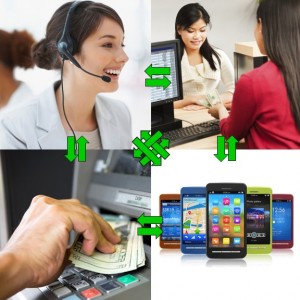Companies like Travelocity, Uber and Yelp have forever changed the way consumers plan their travel and entertainment. Can you remember when you had to book your trips through a travel agency? These innovators have raised the bar for other industries, so can the banking experience be changed in the same way? At least one banking executive thinks so.
 Gareth Gaston is the Executive Vice President of Omnichannel at US Bank, but he hasn’t always been a banking exec. Before his recent move to US Bank, Gaston spent 20 years in the travel industry. It’s probably those years in travel that helped him see what type of experience consumers expect. He says, “The consumer doesn’t give us a pass because we are a bank.”
Gareth Gaston is the Executive Vice President of Omnichannel at US Bank, but he hasn’t always been a banking exec. Before his recent move to US Bank, Gaston spent 20 years in the travel industry. It’s probably those years in travel that helped him see what type of experience consumers expect. He says, “The consumer doesn’t give us a pass because we are a bank.”
During his 2014 BAI Retail Delivery keynote presentation, Gaston defined omni-channel marketing as a shift from individual, in-person interactions to transactions across multiple channels. He chuckled at the obvious understatement when he said, “Omni-channel marketing is marketing on all channels where your customers expect to find you.”
Did you hear that? All channels, not just the bright shiny new channels. It’s not about killing the branch and jumping into social and mobile. It’s a call to provide information and functionality to all of the channels where your customers expect it, including social and mobile, the call center, branch and Internet. “Omni-channel is about moving beyond the digital obsession toward customer centricity,” says Gaston. Getting there is a matter of knowing your customers' expectations.
What does your customer expect from your omni-channel strategy?
- Speed things up.
Give them the channels that put them in control of their time – they don’t have time for long waits on the phone, so you might offer online chat, FAQs and social. - Stop surprising them.
Automatically give them updates and notifications on unseen events that may impact their experience. - Put them in the driver’s seat.
Customers want to be able to complete most functions across each channel and to pick up where they left off in a prior session. - Put your data to work.
Consumers assume that you have in-depth information about who they are, the products they have and the interactions you’ve had in the past. They expect you to use that to offer relevant products and tailored services. - Don’t make them ask.
Wherever possible, make your service automatic. For instance, if I’m a loyal customer with good credit and currently carry one of your credit cards that charges interest, wouldn’t it be in your best interest to offer me your new 0% or rewards card? Automatically. - Appeal to the shopper inside.
Let them compare your products and pricing side by side with your competitors’ products.
Omni-channel marketing isn’t just about branding and functionality. Gaston says it’s about thinking through fundamental processes and policies including pricing, risk policies, fraud policies and product design. “If done right, omni-channel provides increased acquisition, deeper relationships and increased retention,” he explains.
Here are some companies that are getting it right:
Uber offers transparency that puts the customer in control of the experience. “With the Uber app, you can request a cab, know the wait time for a ride and track the car as it progresses. And you get an estimate of the fare, rather than having to guess while watching the meter fly. And finally, you can review the driver and experience once the ride is over,” Gaston explains.
Amazon collects a vast amount of customer data and uses it to provide a personalized experience. When the customer leaves an Amazon shopping session and returns, Amazon tells him what is in his basket, what others like him have chosen, what he’s chosen before and suggestions for what he should choose today.
Progressive has on-the-spot insurance claims resolution. The customer can use the app to take photos of the damage, request roadside service, submit the claim and monitor the claim via the app. The customer gets peace of mind because the information is entered right away. Good for the customer and good for Progressive.
“Banks have a long way to go to be Amazon-esque,” Gaston says. “The most difficult hurdle to overcome will be integrating your siloes. To create that great customer experience, you’ll need to use all of the customer’s data. It will require an organizational change – a change in culture.”
Editor's note:
While customers' expectations may vary slightly among regions or even demographics, this vision for omni-channel and the six customer expectations are spot-on for all industries. And you'll never go wrong by starting with the customer (and the customer's data). That idea is not limited to omni-channel since generally better data means better marketing.
Once you've gotten your data managed, you'll want to use SAS Marketing Automation with its many robust features that enhance the core campaign management function. In a true Omni-channel environment, your customers will use multiple channels whenever it suits them - sometimes simultaneously. In that case, you'll want to use SAS Marketing Optimization so you can maximize your profitability - or however success is defined for your business.
